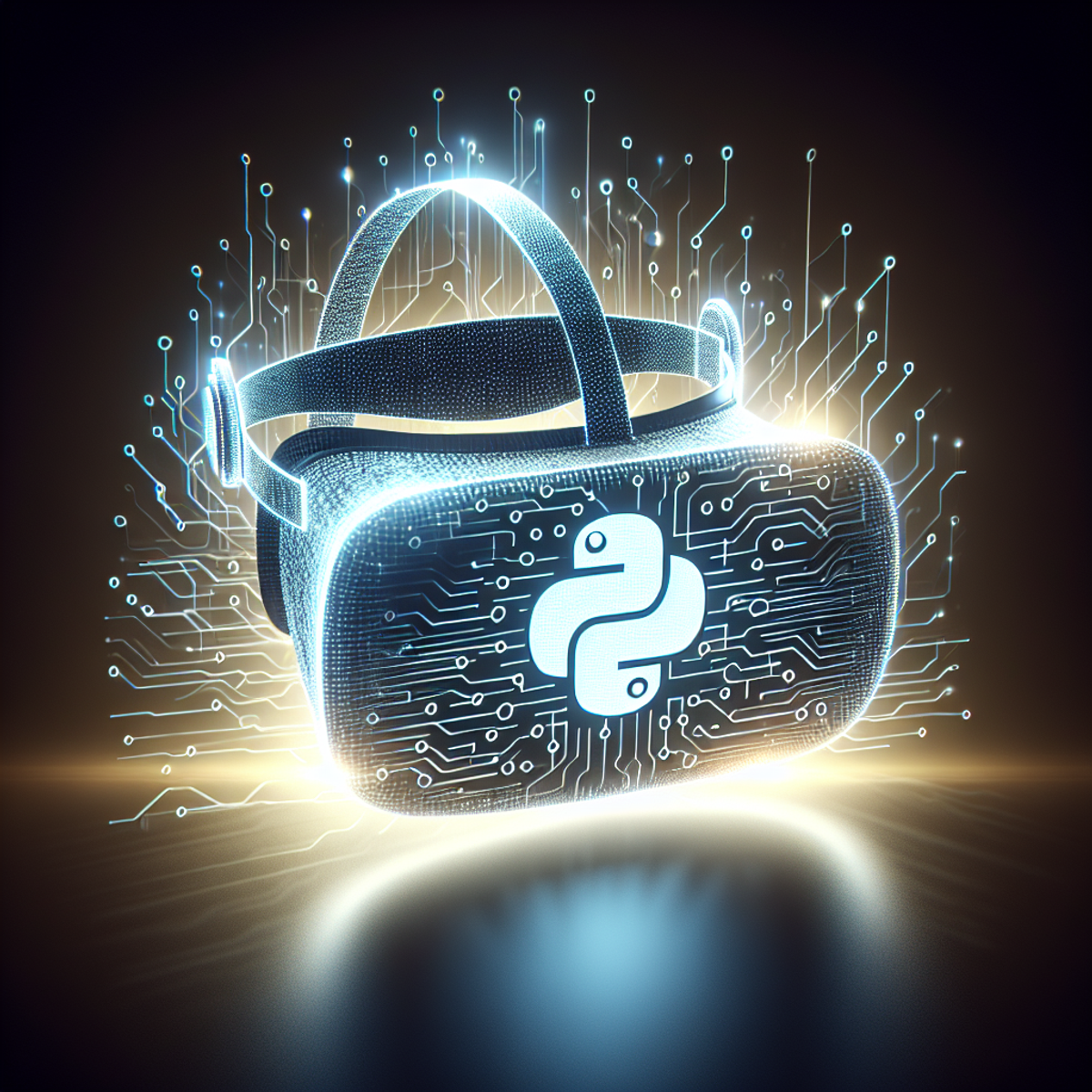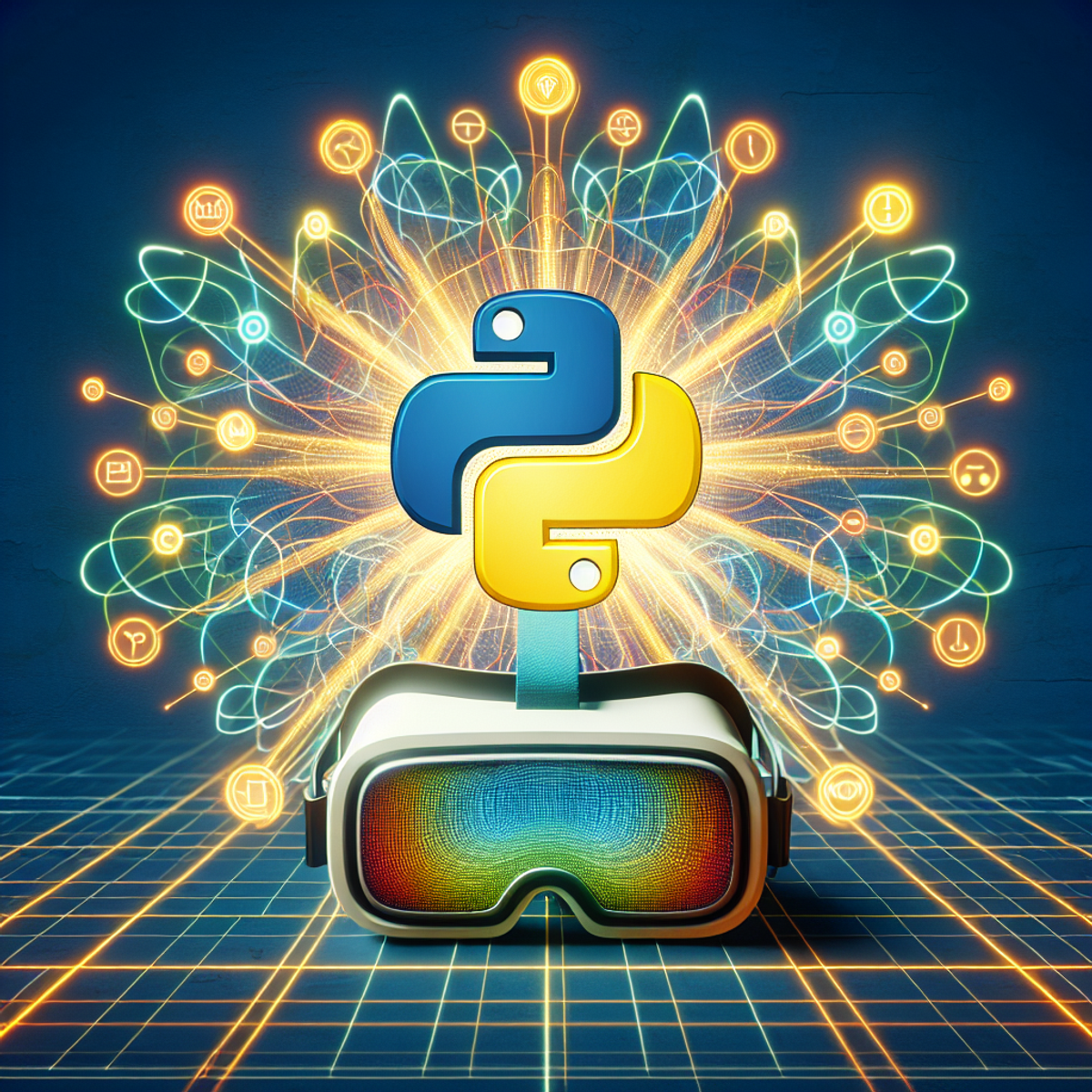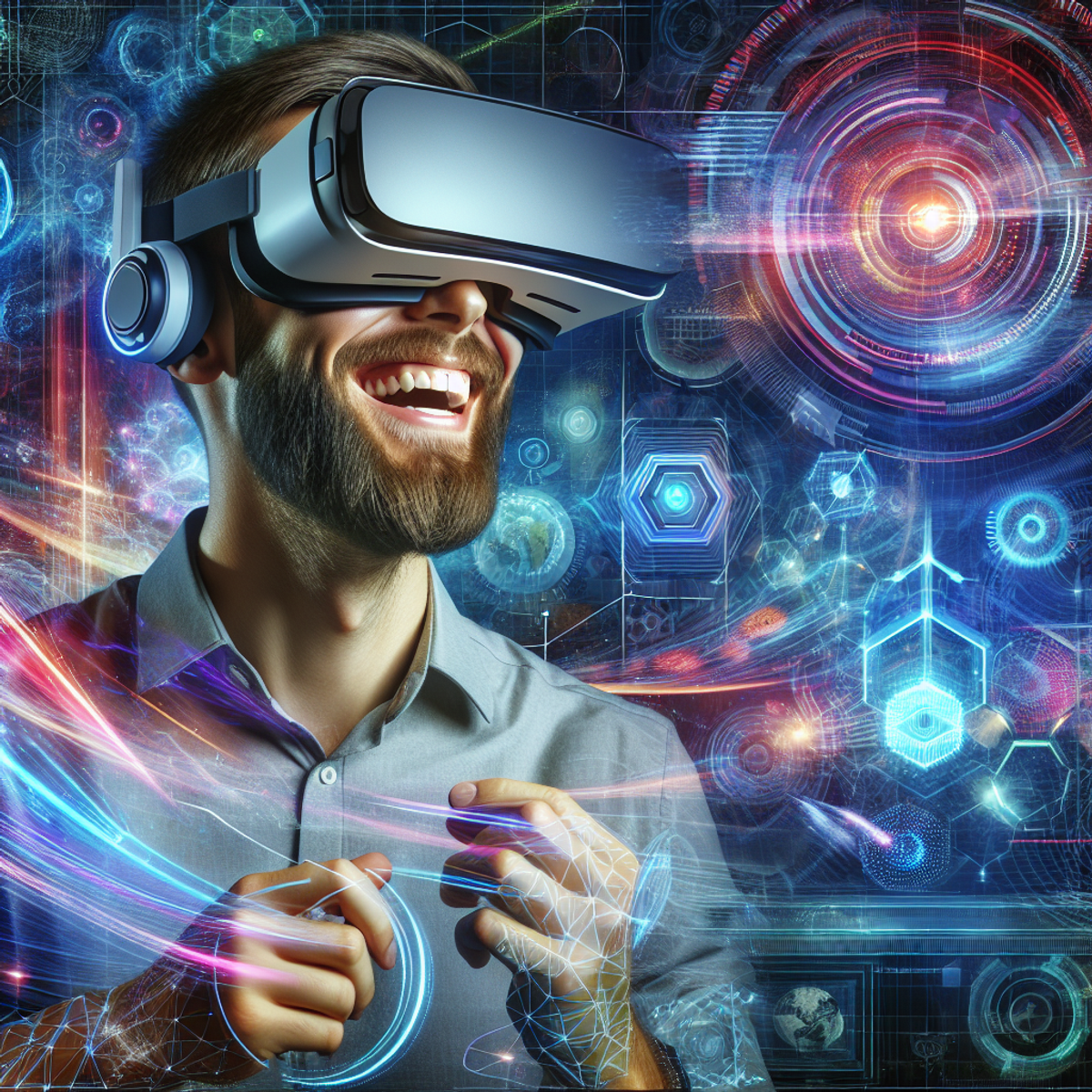Python and Virtual Reality: The Future of VR
Introduction
Virtual Reality (VR) technology has revolutionized the way we interact with digital environments, allowing users to immerse themselves in simulated worlds and experiences. Python, a versatile and accessible programming language, has emerged as a pivotal tool in the development of VR applications, offering a wide range of benefits for both developers and end-users.
Brief explanation of Virtual Reality (VR) technology
VR technology enables users to engage with computer-generated environments in a highly immersive and interactive manner, often through the use of specialized headsets and peripherals. This transformative technology has found applications across various industries, including gaming, healthcare, education, and entertainment.
Overview of Python's role in VR development
Python has become an integral part of VR development, providing developers with a user-friendly and efficient platform for creating immersive experiences. Its accessibility, rich ecosystem, and powerful scripting capabilities have propelled its adoption within the VR community.
Key Takeaway
This article delves into the significance of Python in the realm of VR, highlighting its potential to shape the future of VR experiences. By exploring Python's history, advantages, libraries, performance considerations, and future trajectory in the context of VR development, we aim to showcase its pivotal role in driving innovation and creativity within the VR industry.
Python and Virtual Reality
Python has become a popular language for developing virtual reality (VR) applications. Its flexibility, user-friendly syntax, and powerful scripting abilities make it an ideal choice for creating immersive VR experiences. In this section, we'll look at the specific reasons why Python stands out in the world of VR.
1. Simplified Development Process
Python's simple syntax and high-level nature make it easy for both experienced developers and newcomers to get started with VR development. The straightforwardness of Python code allows for quicker testing and refining of ideas, empowering developers to explore different concepts more efficiently.
2. Abundance of Libraries
Python offers a wide range of libraries that cater to various areas, including VR development. These libraries come with pre-built functions, saving developers time and effort in implementing common VR features. Here are some notable ones:
- Pygame - A popular library that simplifies game development in Python by providing tools for handling graphics, sound, and user input.
- OpenCV - A computer vision library widely used in VR for tasks like tracking user movements, recognizing gestures, and performing real-time object detection.
- NumPy - A fundamental library for scientific computing in Python that offers efficient data structures and functions for numerical operations.
By using these libraries, developers can speed up the development process and focus more on creating captivating VR experiences.
3. Scripting Capabilities
Python's scripting abilities make it an excellent option for building dynamic and interactive VR environments. With Python, developers can easily manipulate objects, control animations, and create complex interactions within the virtual world.
Additionally, Python's integration with other languages such as C/C++ allows developers to combine the performance of lower-level languages with the ease of use and fast development cycle offered by Python. This flexibility enables developers to optimize critical parts of their VR applications without sacrificing productivity.
4. Strong Community Support
Python has a vibrant and supportive community that actively contributes to the growth of VR development. From online forums to open-source projects, developers can find valuable resources, tutorials, and code snippets to accelerate their learning and overcome challenges in VR development.
The community also encourages collaboration and knowledge sharing among developers, fostering innovation in the VR field. Whether it's discussing best practices, sharing insights, or seeking help, the Python community provides a nurturing environment for VR enthusiasts.
In summary, Python's versatility, simplicity, extensive library support, scripting capabilities, and strong community make it an essential tool for virtual reality development. Its user-friendly nature makes it accessible to aspiring VR developers while offering advanced features for experienced professionals. With Python's continuous growth and ongoing advancements in the VR industry, we can expect exciting developments that push the boundaries of immersive experiences.
The Future of Virtual Reality
Virtual Reality (VR) has come a long way since its inception, and the future holds even more exciting possibilities. As technology continues to advance, VR is poised to become an integral part of our everyday lives. Python, with its versatility and accessibility, is set to play a key role in shaping the future of VR experiences.
1. Enhanced Immersion and Realism
One of the main goals of VR is to create immersive experiences that transport users to virtual worlds. In the future, we can expect VR technologies to continue pushing the boundaries of immersion and realism. Python, with its powerful scripting capabilities, will allow developers to create dynamic and interactive virtual environments that respond to user input in real-time.
2. Improved Interaction Design
Interaction design is a crucial aspect of VR experiences. As technology advances, we can expect more natural and intuitive ways of interacting with virtual environments. Python's flexibility and versatility make it an ideal language for developing innovative interaction design techniques. For example, natural language processing (NLP) can be used to enable voice commands or gesture recognition for enhanced user interactions.
3. Integration with Artificial Intelligence
Artificial intelligence (AI) has the potential to revolutionize VR experiences by enabling intelligent agents within virtual environments. Python's extensive libraries for machine learning and AI make it a natural fit for integrating AI technologies into VR applications. Imagine having intelligent NPCs (non-playable characters) that can learn from user interactions and adapt their behavior accordingly.
4. Enhanced Content Creation
Content creation is a vital component of any VR experience. In the future, we can expect Python to play a significant role in automating and streamlining content creation processes. Machine learning algorithms can be leveraged to generate realistic landscapes, characters, and objects in virtual environments.
5. Collaboration and Community Building
Python's supportive community has always been one of its biggest strengths. As VR continues to evolve, collaboration and community building will be crucial for pushing the boundaries of the technology. Python's readability and simplicity make it an excellent choice for collaborative VR projects, allowing developers to work together seamlessly.
6. Integration with Other Technologies
VR is not limited to standalone experiences; it can also be integrated with other technologies to create even more immersive and interactive experiences. Python's versatility allows for seamless integration with technologies such as augmented reality (AR), Internet of Things (IoT), and robotics, opening up a whole new world of possibilities.
7. Accessibility for All
While VR technology has become more accessible over the years, there is still work to be done to ensure that it is available to everyone. Python's easy-to-learn nature and abundance of learning resources make it an ideal language for aspiring VR developers. As the VR community continues to grow, Python will play a crucial role in lowering barriers and democratizing access to this exciting technology.
Python's role in the future of virtual reality is crucial. Its versatility, accessibility, and supportive community make it a perfect fit for developing innovative VR experiences. As technology continues to advance, we can expect Python to enable even more immersive environments, enhanced interaction design, integration with AI technologies, streamlined content creation processes, and seamless integration with other emerging technologies. With Python at its core, the future of virtual reality looks bright and promising.
1. History and Significance of Python in VR Development
The history of Python in the VR industry is marked by its increasing adoption and significance in shaping the landscape of virtual reality experiences. As a programming language, Python has found widespread use in VR development, earning its place as a preferred tool for creating immersive environments and interactive simulations. Its role in major VR platforms has been pivotal, driving innovation and pushing the boundaries of what is achievable in virtual reality.
Adoption by Major VR Platforms
Python's influence in the VR community can be traced back to its integration with prominent platforms such as Oculus and HTC Vive. These platforms have leveraged Python's versatility and ease of use to develop essential components for their VR ecosystems. Additionally, Python's compatibility with popular game engines like Unity and Unreal Engine has further solidified its position as a language of choice for VR development.
Key Advantages for VR Development
The adoption of Python in VR development can be attributed to several key advantages that make it an ideal language for creating immersive experiences:
- Ease of Learning: Python's intuitive syntax and readability have lowered barriers for entry into VR development, allowing newcomers to quickly grasp the fundamentals and start building virtual environments.
- Rapid Prototyping: Python's rapid application development paradigm enables developers to swiftly prototype VR applications, iterate on ideas, and experiment with new concepts, thereby accelerating the innovation cycle within the VR space.
- Community Support: The robust community surrounding Python provides access to a wealth of resources, libraries, and frameworks that are invaluable for tackling complex challenges in VR development. This supportive ecosystem fosters collaboration and knowledge sharing among developers.
Python's significance in the history of VR development lies not only in its technical capabilities but also in its ability to inspire creativity and exploration within the virtual realm. As the demand for immersive experiences continues to grow, Python remains poised to play a pivotal role in shaping the future of virtual reality.
2. Accessibility and Versatility: Why Python is Perfect for VR
Python is an excellent choice for virtual reality (VR) development because it's easy to learn and can be used in many different ways. Here are the main reasons why Python has become so popular among developers working on VR projects:
1. Easy-to-Learn Nature
Python is known for its simplicity and readability, which makes it a great option for beginners who want to get started with VR development. Unlike other programming languages that may have complex syntax or require extensive knowledge of computer science concepts, Python has a straightforward syntax that's easy to understand.
2. Readability and Simplicity
In the world of VR, collaboration is key. Multiple developers often work together on a single project, and being able to understand each other's code is crucial. Python's clear and concise nature makes it easier for team members to read and comprehend the codebase, leading to more efficient collaboration.
3. Abundance of Learning Resources
The Python community is known for its generosity when it comes to sharing knowledge. There are countless tutorials, documentation, and online forums dedicated to helping people learn Python. This wealth of learning resources makes it easier for aspiring VR developers to find the information they need and continuously improve their skills.
4. Supportive Community
Having a supportive community can make a world of difference, especially when you're facing challenges during the development process. The Python community is known for being friendly, helpful, and inclusive. Whether you're looking for advice on best practices or solutions to specific problems, there's always someone willing to lend a hand.
5. Rapid Prototyping with Python
In the early stages of VR development, it's important to quickly test out different ideas and see what works best. Python's rapid prototyping capabilities allow developers to create basic versions of their applications in a short amount of time. This agility is particularly useful when you're exploring new concepts or iterating on existing ones.
6. Flexibility and Versatility in Scripting
VR environments can be dynamic and ever-changing, requiring the ability to adapt on the fly. Python's scripting capabilities make it easy to write custom scripts that can interact with the VR world in unique ways. Whether it's controlling virtual objects, implementing game mechanics, or creating interactive experiences, Python offers the flexibility needed to bring your ideas to life.
In summary, Python's accessibility, supported by its ease of learning, collaborative nature, rich learning resources, rapid prototyping tools, and scripting versatility, positions it as an ideal language for driving innovation in the realm of virtual reality development.
3. Using Python Libraries for Efficient VR Development
When it comes to virtual reality (VR) development, using existing libraries can greatly improve efficiency and make the development process smoother. Python, with its many libraries, offers a wide range of resources that can be used to speed up VR prototyping and scientific research. Here are some benefits of using Python libraries for efficient VR development:
- Access to Shared Libraries: Python has a large collection of shared libraries that cover many functionalities. These libraries can provide pre-built solutions and ready-to-use code snippets, saving developers time and effort. For VR developers, this means access to a lot of resources specifically designed for immersive experiences.
- Faster Prototyping: Python's extensive library ecosystem allows quick prototyping by providing modules that simplify complex tasks. For example, the Pygame library offers tools for handling graphics, sound, and user input, making it great for building interactive VR applications quickly. By using these libraries, developers can focus on creating engaging user experiences instead of starting from scratch.
- Scientific Research Abilities: Python is widely used in scientific research because of its powerful libraries like NumPy, SciPy, and Pandas. These libraries offer useful tools for data analysis, simulation, and visualization - all important parts of VR research. By using these abilities, developers can conduct experiments, analyze data, and optimize their VR applications easily.
- Integration with Hardware: Python libraries often have easy integration with hardware devices commonly used in VR development. For example, the PySerial library allows communication between Python scripts and external hardware like motion sensors or haptic feedback devices. This integration simplifies the process of connecting and controlling devices within a VR environment.
- Community Support: The Python community is known for its active support and collaboration. When using Python libraries for VR development, you can tap into this vast community for assistance, guidance, and feedback. Online forums, documentation, and open-source projects are readily available to help you overcome challenges and gain insights from experienced developers.
- Customization and Extensibility: Python libraries can be easily customized and extended to meet specific VR development requirements. Developers can use the flexibility of Python to modify existing library functionalities or create their own custom modules tailored to their VR projects. This level of customization allows developers to create unique and innovative VR experiences.
It's important to note that while Python libraries offer many advantages for efficient VR development, it's crucial to carefully evaluate the suitability of each library for your specific project. Consider factors such as performance, compatibility with other tools or frameworks, and ongoing support from the library's community.
Using Python libraries can significantly improve efficiency in VR development. The wide range of shared libraries, faster prototyping abilities, scientific research tools, hardware integration options, strong community support, and customization opportunities make Python a powerful tool for creating immersive VR experiences. By using these libraries effectively, developers can make the development process smoother and fully utilize virtual reality technology.
Stay tuned to learn about another important aspect of Python in VR development: addressing performance issues in Python-based VR projects.
4. Addressing Performance Challenges in Python-based VR Projects
Performance is a crucial aspect of Python-based VR projects. Many people are concerned about whether Python can deliver the speed and efficiency needed for virtual reality experiences. However, there are ways to overcome these challenges and optimize performance in Python-based VR projects.
Understanding the Perception and Reality of Performance in Python
Perception: Python as an Interpreted Language
There is a common perception that Python may not offer the same level of performance as lower-level languages like C/C++. This perception stems from the nature of Python as an interpreted language, which can introduce overhead compared to compiled languages.
Reality: Optimization Strategies and Tools
While it is true that interpreted languages generally have some performance overhead compared to compiled languages, Python provides various optimization strategies and tools that can help address these perceived limitations:
- Profiling Tools: Developers can use profiling tools like cProfile and line_profiler to analyze the execution time of different parts of their code. This helps them identify specific areas that may be causing performance issues.
- Module Optimization: Once the performance bottlenecks are identified, developers can focus on optimizing specific modules or functions to improve overall performance.
- Example: Profiling tools such as cProfile and line_profiler enable developers to analyze the execution time of different parts of their code, helping them identify areas that may require optimization.
Keeping Up with Advancements in Hardware Technology
One crucial factor in addressing performance challenges in Python-based VR projects is the rapid advancement of hardware technology, particularly in the realm of GPUs (Graphics Processing Units) and CPUs (Central Processing Units).
GPU Acceleration: Bridging the Performance Gap
Modern GPUs are highly optimized for parallel processing, enabling them to handle complex computational tasks efficiently. This has significantly bridged the performance gap between Python and lower-level languages in the context of VR development.
Example: With the widespread adoption of technologies such as CUDA and OpenCL, developers can harness the power of GPUs for accelerating intensive computational workloads in VR applications developed using Python.
Leveraging Optimized Libraries and Frameworks
Another effective strategy for addressing performance challenges involves leveraging optimized libraries and integrating C/C++ extensions within Python code where critical performance gains are essential.
NumPy: Efficient Array Operations for Scientific Computing
NumPy is a popular library that provides efficient array operations for scientific computing in Python. It is implemented in C and offers high-performance capabilities, making it an excellent choice for numerical computations in VR projects.
Cython: Combining Python Simplicity with C Speed
Cython is another powerful tool that allows developers to write C extensions directly within their Python code. It combines the ease of Python with the speed of compiled languages, making it ideal for optimizing performance-critical sections of VR applications.
By utilizing NumPy's array manipulation capabilities or implementing computationally intensive algorithms using Cython, developers can achieve significant performance enhancements in their VR applications without sacrificing the productivity benefits of Python.
In conclusion, while performance considerations are indeed relevant in Python-based VR projects, advancements in hardware technology and optimization strategies have effectively mitigated many of the perceived limitations. By leveraging profiling tools, embracing GPU acceleration, and integrating optimized libraries and frameworks, developers can ensure that their Python-based VR applications deliver compelling experiences without compromising on performance.
The Promising Trajectory of Python and VR
Python's role in the future of VR is poised to be transformative, with the potential to push the boundaries of VR technology and user experiences. As VR continues to evolve, Python stands to play a pivotal role in shaping its trajectory, particularly in the following areas:
1. Machine Learning for VR Content Generation
The integration of machine learning (ML) algorithms with VR has the potential to revolutionize content creation in virtual environments. Python's extensive libraries for ML, such as TensorFlow and PyTorch, can be leveraged to develop intelligent systems that generate dynamic and adaptive VR content in response to user interactions. This fusion of ML and VR holds promise for creating immersive experiences that dynamically adjust to user preferences and behavior.
2. Enhanced Interaction Design through Natural Language Processing (NLP)
Natural Language Processing (NLP) presents an exciting frontier for enhancing interaction design in VR applications. By harnessing Python's NLP libraries like NLTK and spaCy, developers can explore the integration of voice commands, natural language understanding, and conversationally-driven interactions within virtual environments. This convergence of NLP and VR has the potential to elevate user engagement and redefine how individuals interact with virtual spaces.
The synergy between Python's robust ecosystem and the evolving landscape of VR technologies opens up possibilities for groundbreaking advancements in user experiences. As Python continues to innovate alongside developments in VR, it is poised to enrich the realm of immersive technologies through innovative applications and novel approaches.
Embracing Python as a versatile tool for exploring creative possibilities in VR experiences not only fosters innovation but also underscores its enduring relevance in shaping the future of virtual reality.
With Python at the forefront of driving innovation in VR development, its significance extends beyond conventional paradigms, ushering in an era of unprecedented creativity and exploration within virtual realms.
Conclusion
Python has become an essential tool in developing virtual reality (VR) experiences, driving innovation in the VR industry. Its accessibility, versatility, and extensive library support make it ideal for creating immersive VR applications.
- Python's easy-to-learn nature and simplicity make it a great choice for aspiring VR developers.
- Its clean syntax and readable code foster better collaboration and faster prototyping in VR projects.
- The abundance of learning resources and a supportive community within the Python ecosystem ensure that developers have the necessary guidance to explore the creative possibilities of VR.
Existing Python libraries further enhance the efficiency of VR development. By using these libraries, developers can access pre-built functions for scientific research and speed up their VR prototyping. This saves time and allows them to focus on improving the user experience.
While some have raised concerns about Python's performance compared to lower-level languages like C/C++, advancements in hardware technology have reduced these limitations. Modern GPUs and CPUs offer significant speed improvements, narrowing the performance gap between Python and compiled code.
Looking ahead, Python has exciting potential in shaping the future of VR technology:
- Machine learning techniques can generate dynamic and personalized VR content, offering users more immersive experiences.
- Natural language processing (NLP) can enhance interaction design by enabling users to communicate with virtual environments using voice commands or gestures.
Embracing Python as a tool for exploring creative possibilities in VR experiences is highly encouraged. Its user-friendly nature, extensive community support, and robust library ecosystem make it an ideal choice for both beginners and seasoned professionals in the VR industry.
So what are you waiting for? Dive into Python and unlock a world of possibilities in the exciting realm of virtual reality!
FAQs (Frequently Asked Questions)
What is the history and significance of Python in VR development?
The history of Python in the VR industry dates back to its adoption by major VR platforms. Python has become a preferred language for VR development due to its simplicity, readability, and ease of learning, making it accessible for aspiring VR developers.
Why is Python considered perfect for VR in terms of accessibility and versatility?
Python is considered perfect for VR due to its easy-to-learn nature, which lowers barriers for aspiring VR developers. Additionally, the abundance of learning resources and a supportive community in the Python ecosystem, along with its flexibility and versatility for scripting in VR environments, make it an ideal choice for VR development.
How can Python libraries be leveraged for efficient VR development?
Python libraries can be utilized for scientific research and accelerated VR prototyping, offering benefits such as shared functionality and resources that can expedite the development process.
What are the strategies to address performance challenges in Python-based VR projects?
To address performance challenges in Python-based VR projects, developers can optimize applications through profiling and module optimization techniques. It's also important to note that advancements in hardware technology, such as GPUs, have mitigated the performance gap between Python and lower-level languages like C/C++ in the context of VR development.
What are the future possibilities for Python in pushing the boundaries of VR technology and user experiences?
The future possibilities for Python in VR include areas such as machine learning for content generation and enhanced interaction design through natural language processing (NLP). These advancements have the potential to shape the future of VR experiences and drive innovation in the industry.
What are the final thoughts on the unique value proposition of Python in driving innovation in the VR industry?
In conclusion, Python offers a unique value proposition in driving innovation in the VR industry. Embracing Python as a tool for exploring creative possibilities in VR experiences can lead to exciting future prospects and advancements in virtual reality technology.

Comments
Post a Comment